Is Gold Plated Jewelry Good? The Pros and Cons Revealed
When shopping for jewelry, you may come across two options: solid gold or gold plated. But is gold plated jewelry actually good? And how does it compare to the real deal?
What is gold plating?
Gold plating involves coating a base metal like nickel or silver with a thin layer of gold, usually anywhere from 1 to 25 microns thick. The gold acts as a decorative finish that gives the illusion of being solid gold.

Is gold plated jewelry hypoallergenic?
The gold plating itself is hypoallergenic but other metals in the jewelry piece can cause allergic reactions. Especially, when the external golden layer peels off, the underneath nickel comes into contact with the skin. Also, the core metals, such as copper, zinc, or silver, can cause reactions.
Before purchasing jewelry with gold plating, learn about the metal alloys used in it. Avoid the ones that have metal you are allergic to.

The Pros of Gold Plated Jewelry
- More affordable: Since only a thin layer of gold is used, plated pieces cost a fraction of solid gold jewelry.
- Variety of base metals: Gold can be plated on many metals to suit different styles, from silver to copper to stainless steel.
- Less prone to scratches: The gold layer acts as a barrier, protecting the softer base metal from everyday wear and tear.
- Easy to repair: If the gold plating becomes damaged, it’s often possible to just re-plate the surface rather than replacing the entire piece.
- Lighter weight: Without a solid gold core, plated jewelry tends to weigh less and feel more comfortable to wear.
The Cons of Gold Plated Jewelry
- Shorter lifespan: The gold plating will inevitably wear off over time with daily use, exposing the base metal underneath.
- Tarnish and corrosion: The base metal can still tarnish or corrode under the thin gold layer, marring the jewelry’s finish.
- Wear from contact: Plating on surfaces that rub together, like rings, tends to wear off faster.
- Difficult to restore: Once the gold plating is extensively worn, the piece often cannot be replated and must be replaced.
- Lower resale value: Gold plated jewelry almost always commands a much lower price if resold compared to solid gold pieces.
While gold plated jewelry is more affordable initially, solid gold will almost always provide higher quality, a more luxurious feel and a longer lasting product. So whether gold plated jewelry is “good” depends largely on your priorities and goals.
For those seeking an attractive but relatively inexpensive piece, gold plating can offer an appealing illusion of wealth at a fraction of the cost. But if you value durability, longevity and the highest possible gold content, solid gold jewelry will likely prove a better long-term investment. Ultimately it comes down to balancing your budget with your preferences for quality, longevity and resale value. Just keep the pros and cons of gold plating in mind so you can choose options that check the most important boxes for you.

FAQs
Gold-plated jewelry is almost always going to be less expensive than solid gold pieces to purchase initially. However, it generally will not hold its value as well, so you aren’t likely to make much of your investment back if you try to sell it again in the future.
Tarnishing: The main con with gold plating, rather than using real gold, is tarnishing. Tarnishing is likely to occur over a long period of time due to wear and tear, causing the metal underneath the gold plating beginning to show through.
No, gold-plated does not mean fake. Gold-plated jewelry uses the same gold for its golden layer as solid gold jewelry. The only difference is that solid gold is made entirely of gold and alloys, while gold-plated jewelry has a metal base that is covered in gold.
Not only does gold plated jewellery capture the natural light but it also captures the beauty of the wearer. However, over time the jewellery can lose its shine and become slightly tarnished. This can happen when the gold reacts with moisture and air leading it to oxidize.
Want to know more? Find information here.
